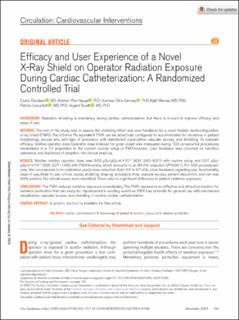| dc.description.abstract | BACKGROUND:
Radiation shielding is mandatory during cardiac catheterization, but there is a need to improve efficacy and ease of use.
METHODS:
The aim of the study was to assess the shielding effect and user feedback for a novel flexible multiconfiguration x-ray shield (FMX). The 0.5-mm Pb equivalent FMX can be selectively configured to accommodate for variations in patient morphology, access site, and type of procedure with maintained visualization, vascular access, and shielding. To evaluate efficacy, relative operator dose (operator dose indexed for given dose) was measured during 103 consecutive procedures randomized in a 1:1 proportion to the current routine setup or FMX+routine. User feedback was collected on function, relevance, and likelihood of adoption into clinical practice.
RESULTS:
Median relative operator dose was 3.63 μSv/µGy·m2×10–3 (IQR, 2.62–6.37) with routine setup and 0.57 μSv/µGy·m2×10–3 (IQR, 0.27–1.06) with FMX+routine, which amounts to an 84.4% reduction (P<0.001). For 500 procedures/year, this corresponds to an estimated yearly dose reduction from 3.6 to 0.7 mSv. User feedback regarding size, functionality, ease of use, likely to use, critical issues, shielding, draping, procedure time, vascular access, patient discomfort, and risk was 99% positive. No critical issues were identified. There was no significant difference in patient radiation exposure.
CONCLUSIONS:
The FMX reduces radiation exposure considerably. The FMX represents an effective and attractive solution for radiation protection that can easily be implemented in existing workflow. FMX has potential for general use with maintained visualization, vascular access, and shielding in routine cardiac catheterization. | en_US |

